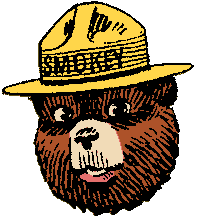
| Gallery [ Support the RFFD] |
Fire Prevention In The Outdoors

As Smokey Bear says:
Only You Can Prevent Forest Fires!
IF YOU SEE A FIRE: Dial 911
Give as much detail about the fire's location as you can, including mile marker or red property numbers and landmarks. Stay on the telephone until the dispatcher tells you to hang up.
We like detail: "A caller reported smoke on the south side of the Canyon visible from in front of house number XXX. It is a sporadic dark column, and appears to be well up on the side of the ridge. No flames are visible. The caller will be waiting in front of house number XXX in order to point out what they saw."
To help you get oriented in the canyon: The creek side is South, the opposite side is North. Towards Angel Fire ('up canyon') is East. Towards Taos ('down canyon') is West.
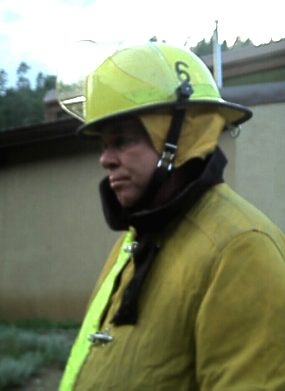
Prepared for: TAOS CANYON NEIGHBORHOOD ASSOCIATION
By: Louis Zamora
Wildland Fires: Preparedness fact sheet
The threat of wildfires for people living in Taos Canyon is real and can strike without warning because of the drought conditions. People can be forced to evacuate or worse, endure confinement in your home, if not prepared. People have acquired secluded homes surrounded by forests, mountains and meadows, which have come to be known in firefighter lingo as the wildland/urban interface. If you want to protect your home, forest and community, it is your responsibility, as the homeowner, to take action. Take the time to prepare for disaster by reviewing these five easy steps and practice self-reliance by taking action on your own using the fact sheet:
1. Discuss the disasters happening in your area, with
your family, neighbors and community.
2. Train all family members. Take first aid classes.
Learn how to use a fire extinguisher and how to shut
off utilities. Don't take a chance that the only
person who knows first aid or how to turn off the gas
will be at home when needed.
3. Assemble supplies including food, water and
emergency tools. A list is enclosed and involves your
family and neighbors.
4. Identify emergency name and numbers, (family, fire
department etc.) make copies for each member of your
family to keep.
5. Maintain your readiness. Review your plan at least
once a year to determine what training, equipment and
supplies are needed.
Remember, do not misconstrue that wildland/urban interface protection is solely a Forest Service concern. Contrary to these expectations, the Forest Service has neither the resources for effectively protecting highly ignitable homes during severe wildfires, nor the authority to reduce home ignitability. Instead, homeowners need to take the responsibility for assuring adequately low home ingnitability and take steps to reduce home fire loss potential.
PREVENTIVE MITIGATION!
Mitigation - to work together to prevent an emergency,
reduce the chance of an emergency happening, or lessen
the damaging effects of unavoidable emergencies.
Here are some things you need to know before, during,
and after a wildfire and take action on:
BEFORE:
Checklist to help you protect your Family:
Create a disaster plan, know your area, property contours and boundaries.
Create an emergency route to take and know where to go
if wildfires threaten your area.
Plan several escape routes away from your home - by
car and by foot.
Pick two meeting Places:
1. A place a safe distances from your home.
2. A place outside Taos Canyon in case you can't
return home.
Choose an out-of-state family/friend as a
"check-in-contact" for everyone to call.
Tell your contact you are leaving and where you are
going.
Post emergency telephone numbers by every phone.
Develop an emergency communication plan. In case
family members are separated from one another during a
wildland fire (a real possibility during the day when
adults are at work and children at home, school,
etc.), have a plan for getting back together.
Show responsible family members how and when to shut
off water, gas and electricity at main switches.
Learn first aid and CPR.
Teach each family member how to use the fire
extinguisher (ABC type) and show them where it's kept.
Keep protective clothing for every member of your
family nearby.
Wear protective clothing in an emergency - sturdy
shoes, cotton or woolen clothing, long pants, a
long-sleeved shirt, gloves and a handkerchief to
protect your face.
Put together a disaster supply kit -
1. First aid kit and manual
2. Emergency non-perishable food and water
3. Flashlight with extra batteries
4. Portable, battery-operated radio and extra
batteries
5. Extra clothing and sturdy shoes
6. Non-electric can opener
7. Cash and credit cards
8. Important personal documents
9. Sanitation supplies.
10. Special items for infant, elderly or disabled
family members.
11. An extra pair of eyeglasses.
Store these supplies in sturdy, easy-to-carry
containers such as backpacks, dufflebags or trash
containers.
Know where your disaster kit is located, if you are
evacuated.
Confine pets to one room. Plan for their care if you
must evacuate and keep them under control conditions
during evacuation.
Arrange for temporary housing outside the threatened
area.
If advised to evacuate, do so immediately.
Practice fire escape and evacuation plans.
Teach children about fire safety. Keep matches and
lighters out of their reach.
Talk to your neighbors about wildfire safety. Plan
how the neighborhood could work together, for a safe
Taos Canyon. Make a list of your neighbors' skills
such as medial and technical. Consider how you could
help neighbors who have special needs such as elderly
or disabled person. Make plans to take care of
children who may be on their own if parents can't get
home.
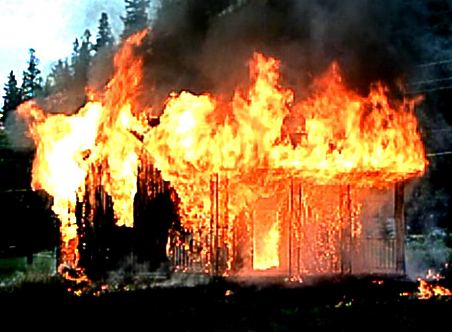
Checklist to protect your home:
Have chimney inspected and cleaned annually by a
certified specialist.
Insulate chimneys and place spark arresters on top.
Extend the chimney at least three feet above the roof.
Remove branches hanging above and around the chimney.
Provide at least two ground level doors for safety
exits and at least two means of escape -either a door
or window - in each room, so that everyone has a way
out.
Make an occasional inspection of your home, looking
for deterioration such as breaks and spaces between
roof tiles, warping wood, or cracks and crevices in
the structure.
Also, inspect your property, clearing dead wood and
dense vegetation from at least 30 feet from your
house, and moving firewood away from the house or
attachments, like fences or decks.
Install smoke alarms on every level of your home. Test
them monthly and change the batteries at least once a
year.
Never leave a fire--even a cigarette--burning
unattended. Mark the entrance to your property with
signs that are clearly visible.
Provide emergency vehicle access through roads and
driveways at least 12 feet wide with adequate
turnaround space.
Report hazardous conditions that could cause a
wildfire.
Use fire-resistant and protective roofing and
materials like stone, brick and metal to protect your
home. Avoid using wood materials that offer the least
fire protection.
Clear roofs and eaves of debris.
Cover all exterior vents, attics and eaves with metal
mesh screens no larger than 6 millimeters.
Install multipane windows, tempered safety glass or
fireproof shutters to protect large windows from
radiant heat.
Use fire-resistant draperies for added window
protection.
Keep on hand household items that can be used as fire
tools: a rake, axe, handsaw or chainsaw, bucket and
shovel, ladder and 100 foot garden hose that is long
enough to reach any area of the home and other
structures on the property.
Stonewalls can act as heat shields and deflect flames.
Swimming pools and patios can be a safety zone.
Prune all branches around the residence to a height of
8 to 10 feet. Keep trees adjacent to buildings free of
dead or dying wood and moss.
Remove all dead limbs, needles, and debris from rain
gutters.
Store combustible or flammable materials in approved
safety containers and keep them away from the house.
Avoid open burning completely and especially during
dry season.
Identify and maintain an adequate outside water source
such as a small pond, cistern, well, swimming pool or
hydrant.
Make sure water sources, such as hydrants and ponds,
are accessible to the fire department.
Install freeze-proof exterior water outlets on at
least two sides of the home and near other structures
on the property. Install additional outlets at least
50 feet from the home.
Consider obtaining a portable gasoline powered
pump/generator in case electrical power is cut off.
Keep all trees and shrub limbs trimmed so they don't
come in contact with the wires.
Any structures attached to the house, such as decks, porches, fences, and outbuildings should be considered part of the house. These structures can act as fuses or fuel bridges, particularly if constructed from flammable materials. Therefore, consider the following:
If you wish to attach an all-wood fence to your home,
use masonry or metal as a protective barrier between
the fence and house.
Use non-flammable metal when constructing a trellis
and cover with high-moisture, nonflammable vegetation.
Prevent combustible materials and debris from
accumulating beneath patio deck or elevated porches;
screen under or box in areas below ground line with
wire mesh no larger than 1/8 of an inch.
Make sure an elevated wooden deck is not located at
the top of a hill where it will be in direct line of a
fire moving up slope; consider a terrace instead.
Constructing, renovating or adding consider the
following:
Obtain local building codes and weed abatement
ordinances for structures built near wooded areas.
Choose a firewise location.
Design and build a firewise structure.
Employ firewise landscaping and maintenance.
To select a firewise location, observe the following:
1. Slope of terrain;
2. Be sure to build on the most level portion of the
land, since fire spreads rapidly, even on minor
slopes.
Set your single-story structure at least 30 feet back
from any ridge or cliff; increase distance if your
home will be higher than one story.
In designing and building your firewise structure,
remember that the primary goals are fuel and exposure
reduction.
Use construction materials that are fire-resistant or
non-combustible whenever possible.
For roof construction, consider using materials such
as Class-A asphalt shingles, slate orclay tile, metal,
cement and concrete products, or terra-cotta tiles.
Install electrical lines underground, if possible.
Avoid using wooden shakes and shingles for a roof.
Use only thick, tempered safety glass in large windows
and sliding glass doors.
Constructing a fire-resistant sub-roof can add
protection, as well.
On exterior wall cladding, fire resistive materials
such as stucco or masonry are much better than vinyl,
which can soften and melt.
Consider both size and materials for windows; smaller
panes hold up better in their frames than larger ones;
double pane glass and tempered glass are more
effective than single pane glass; plastic skylights
can melt.
Cover windows and skylights with non-flammable
screening shutters.
To prevent sparks from entering your home through
vents, cover exterior attic and under floor vents with
wire mesh no larger than 1/8 of an inch;
make sure
undereave and soffit vents are closer to the roof line
than the wall;
and box in eaves, but provide adequate
ventilation to prevent condensation.
Include a driveway that is wide enough - 12 feet wide
with a vertical clearance of 15 feet and a slope that
is less than 12 percent - to provide easy access for
fire engines.
The driveway and access roads should be
well maintained, clearly marked, and include ample
turnaround space near the house.
Also consider access
to water supply, if possible.
Checklist to Maintain a Defensible Space:
Follow these basic rules to create defensible space that
works.
(Something to remember: 78% of the houses with a
30-ft. defensible space survives)
Landscape your property with fire-resistant plants and
vegetation to prevent tire from spreading quickly.
Remove all dead plants, trees and shrubs from the
site.
Reduce excess leaves, plant parts and Iow-hanging
branches.
Replace dense flammable plants with fire-resistant
plants.
Create a defensible space perimeter, be sure to leave
a minimum of 30' around the house to accommodate fire
equipment, if necessary.
Within the defensible space, take out the "ladder
fuels" -- vegetation that serves as a link between
grass and tree tops. It can carry fire to a structure
or from a structure to vegetation.
Give yourself added protection with "fuel breaks" like
driveways, gravel walkways, and lawns.
Beyond 30 feet, (300' from the house) remove dead
wood, debris and low tree branches and keep vegetation
trimmed and pruned.
Eliminate small trees and plants growing under trees.
They allow ground fires to jump into tree crowns.
Space trees 30 feet apart and prune to a height of 8
to 10 feet.
Place shrubs at least 20 feet from any structures and
prune regularly.
Plant the most drought-tolerant vegetation within
three feet of your home and adjacent to structures to
prevent ignition.
Provide at least a 10 to 15 foot separation between
islands of shrubs and plant groups to effectively
break-up continuity of vegetation.
Create tire-safe zones with stone walls, patios,
swimming pools, decks and roadways.
Ask the power company to clear branches from
powerlines.
Clear a 10-foot area around propane tanks and the
barbecue.
Place a screen over the grill-use
non-flammable material with mesh no coarser that
one-quarter inch.
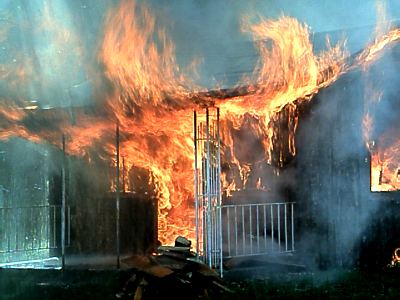
Checklist for Landscaping to defend your property:
The choice of plants, spacing and maintenance are
crucial elements in any defensible space.
Carefully space the trees you plant.
Trim grass on a regular basis up to 100 feet
surrounding your home.
Beyond 30 feet, remove dead wood, debris and Iow tree
branches.
Landscape your property with fire resistant plants and
vegetation to
prevent fire from spreading quickly.
Stack firewood at least 30 feet away from your home
and other structures.
Store flammable materials, liquids and solvents in
metal containers outside the home, at least 30 feet
away from structures and wooden fences.
Check your local nursery or county extension service
for advice on fire resistant plants that are suited
for the Taos Canyon environment.
Use rock, mulch, flowerbeds and gardens as ground
cover for bare spaces and as effective firebreaks.
There are no "fire-proof' plants. Select high moisture
plants that grow close to the ground and have a low
sap or resin content.
Choose plant species that resist ignition such as Snow
in summer, Creeping thyme, Ice plant and Periwinkle.
Fire-resistant shrubs include Sand cherry, Elderberry,
Woods rose, Virginia creeper, Skunkbrush sumac and
Lilac.
Plants should be low-growing, and well-spaced trees in
this area, remembering to keep the volume of
vegetation (fuel) low.
Keep trees and shrubs pruned. Prune all trees up to 6'
to 10' from the ground.
Remove leaf clutter and dead and overhanging branches.
Mow your lawn regularly.
Dispose of cuttings and debris promptly, according to
local regulations.
Be sure the irrigation system is well maintained.
Use care when refueling garden equipment and maintain
it regularly.
Store and use flammable liquids properly.
Dispose of smoking materials carefully.
Become familiar with local regulations regarding
vegetative clearances, disposal of debris, and fire
safety requirements for equipment.
Follow manufacturers' instructions when using
fertilizers and pesticides.
DURING:
Should emergency conditions occur take the following
actions:
Be ready to evacuate all family members and pets when
fire nears or when instructed to do so by local
officials.
Listen to your radio for reports and evacuation
information.
Turn on a battery-operated radio to get the latest
emergency information.
Remove combustible items from around the house.
1. Lawn and poolside furniture
2. Umbrellas
3. Tarp coverings
4. Firewood
Move flammable furniture into the center of the home
away from windows and sliding-glass doors.
Take down flammable drapes and curtains and close all
venetian blinds or noncombustible window coverings.
Take action to protect your home.
1. Close all doors and windows inside your home to
prevent draft.
2. Close gas valves and turn off all pilot lights.
3. Turn on a light in each room for visibility in
heavy smoke.
4. Place valuables that will not be damaged by water
in a pool or pond.
5. If hoses and adequate water are available, leave
sprinklers on roofs and anything that might be damaged
by fire.
Back your car into the garage or park it in an open
space facing the direction of evacuation.
Close back doors and windows.
Leave the key in the ignition.
Close garage window and doors, but leave them
unlocked.
Disconnect automatic garage door openers.
Tell someone when you are leaving and where you are
going.
If you evacuate your home place a note on the door
indicating when you left and where you are going.
Wear protective clothing in an emergency - sturdy
shoes, cotton or woolen clothing, long pants, a
long-sleeved shirt, gloves and a handkerchief to
protect your face.
Take your disaster supplies kit.
Lock your home.
Choose a route away from fire hazards.
Watch for changes in the speed and direction for fire and smoke.
AFTER:
DO NOT ENTER YOUR HOME, until authorities notify you
that it is safe to return, do not take any risks.
Take care when re-entering a burned wildland area. Hot
spots can flare up without warning. When you are
cleared to re-enter, check the roof immediately and
surrounding area around the home and any evidence of
hot spots, extinguish any sparks or embers. Check the
attic for hidden burning sparks. For several hours
afterward, re-check for smoke and sparks throughout
the home.
If trapped in a Wildland Fire, crouch in a pond or river if possible. If water is not around, look for shelter in a cleared area or among a bed of rocks. Lie flat and cover the head and upper body with dry
clothing or soil. Dig a small hole and put your face in it. Breathe the air close to the ground to avoid scorching lungs or inhaling smoke. The greatest immediate danger to life is breathing superheated air or steam.
From the Project Manager:
This information is part of the "The Taos Canyon Fire
Protection Plan", currently underway and is not
complete, but pertinent information was extracted for
distribution in a "checklist format". The grant was
awarded to the community of Taos Canyon, by the U.S.
Forest Service and the goal to build on the foundation
of this fire protection plan, to create effective fire
protection programs; and further develop permanent
protection through a conservancy program.
The Taos Canyon community, in helping to solve current
wildfire crisis, must come together, work together and
develop proper management, problem-solving
capabilities.
Acknowledgments: I gratefully acknowledge the information provide by the US Forest Service, FEMA, NM State Forestry, EPA, USGS and BLM.
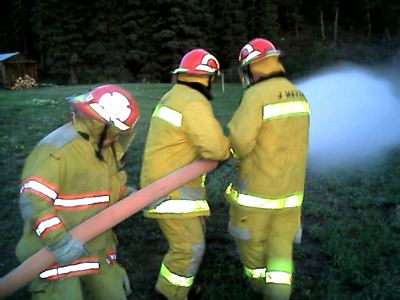
Fire Prevention In The Home
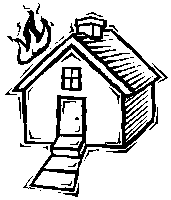 |
•U.S. fire departments responded to an estimated average of 358,300 home structure fires per year during 2010-2014, which represents three-quarters of all structure fires.
•On average, seven people died in U.S. home fires per day.
|
General Fire Safety Tips
Keep a fire extinguisher in your home and car, and read the directions.
Don't smoke. If you must smoke, don't smoke in bed. Keep cigarettes and ashtrays away from curtains, upholstered furniture, and other combustibles, and make sure they are dead out when you are finished.
Remember that smoke, heat and toxic gases from fires can kill you long before flames get to your part of the structure. KEEP LOW when evacuating.
GET OUT of your house if you have a fire - call 911 from your neighbor's house.
Remember that lives are much more valuable than property. If you're out of the building, STAY OUT!
Set up Evacuation Drills In The Home - practice evacuating your house, and meeting at the designated point OUTSIDE.
Fire Safety Tips Regarding Children
Keep matches and lighters out of the reach of children.
Teach your children never to play with matches, lighters, or fireworks.
Teach your children how to call 911, as well as their address and telephone number.
Teach your children the "Stop, Drop, and Roll" method to extinguish flames on themselves.
Cooking
Never "Barbecue" or grill indoors on a smoker or barbecue grill. Use these devices at least 30 feet from any structures.
Don't leave food unattended on the stove.
Keep dangling clothing away from burners.
Turn handles on pots and pans so that they can't be knocked off the stove accidently.
Make sure your stove is turned off and small appliances are turned off or unplugged before leaving the house or going to bed.
Fire Safety In Your Vehicle
Don't fill your portable gasoline cans in your vehicle - remove the can from the vehicle.
When transporting portable gasoline cans, ensure that the container
is approved for gasoline storage, is sealed tightly, and
is not left in the vehicle for longer than absolutely necessary, especially on a warm or sunny day.
If you smell gasoline or suspect a gasoline leak, don't operate the car until the leak is repaired.
If you smell smoke or see flames, pull over well off the traveled roadway as soon as safely possible to do so. Don't attempt to drive any further.
Electrical and Heating Hazards
Replace frayed or cracked electrical wiring.
Don't run electric power cords under rugs.
Always look for the Underwriters Laboratory (UL) or Factory Mutual (FM) labels when purchasing appliances, storage containers or electrical accessories.
Plug electric space heaters directly into the wall socket, not into extension cords.
Place heaters where they will not be knocked over easily, and unplug when they are not in use.
Do not use heaters to dry clothing or other items.
Make sure your fireplace or woodburning stove is clean and in good repair before using it.
Keep all combustible materials well away from the heat.
Make sure you use the proper fuel for your heating device:
DON'T use gasoline in a kerosene heater.
DON'T burn coal in a device meant to burn wood.
Don't store gasoline or other explosives in your house.
Smoke Detectors
Check your smoke detectors monthly, and replace the batteries in them in the spring and fall when you adjust your clocks.
Install at least one smoke detector on each floor of your house, away from air vents, and at least six inches away from walls and corners.
Install smoke detectors near all bedrooms.
If there are any smokers in the house, install a smoke detector in their bedroom.
If your smoke detector sounds while you are in bed, DON'T SIT UP! Roll out of bed, and stay low to the floor - remember that the heat and toxic gases are up higher.
Carbon Monoxide (CO) Detectors
If you burn anything in your house, such as wood, natural gas, propane, kerosene, or coal, install a Carbon Monoxide (CO) detector. This device can warn you of potentially deadly CO gas before the concentration reaches the harmful level.
Learn the warning signs of CO poisoning: redness of the skin, headaches, dizziness, nausea, weakness, loss of muscle control, chest tightness, heart fluttering, sleepiness, confusion, vomiting or diarrhea. If more than one person in the household is sick, and they feel better after being away from the house for a while, CO poisoning should be suspected. If you suspect CO poisoning, get out of the house and call the fire department.
| Gallery [ Support the RFFD] |